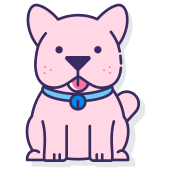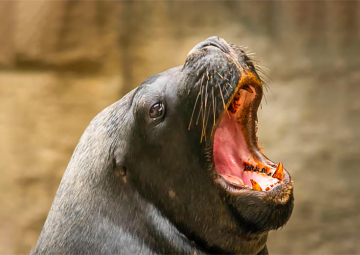GENERAL
Voluntary blood draw in white rhinoceros (ceratotherium simum)

Marco Aurelio Núñez is a zootechnician veterinarian from the Autonomous University of Aguascalientes (México), since 2015. He has had professional training in the area of clinical ethology in different academic and zoological institutions in Mexico and in 2020 he worked as a zookeeper and trainer at the "Entre picos y plumas" exhibition at Guadalajara Zoo (Mexico).
Currently, he directs his pets consultancy "Positivet" dedicated to the prevention and resolution of behavioral problems.
Introduction
In 2019, we had the opportunity to work with Titan, a 38-year-old white rhinoceros (Ceratotherium simum) weighing about 2 tons. Titan had a prior learning of certain behaviors such as standing in a crush cage area or desensitizing to be touched.
The "personality" or "animality" of Titan, we could define it as “extroverted", "friendly" but at the same time "impatient" and "intolerant" when under the context of non-invasive and invasive human interaction. For example, Titan likes to interact with his caregivers across the perimeter of his enclosure, but the same was not true inside the crush cage, as he refused or attempted to remove the wooden front posts.
White rhinos under human care are not exempt from eye disease, respiratory tract disease, locomotive system or physical injury, so it was very important to start making a cooperative behavioral plan for Titan.
{youtube}https://youtu.be/ZwQ5l4jvBf0{/youtube}
Read and observe before training
The first step was to look for scientific information about what a rhinoceros was in general and in particular about a white rhinoceros, because of the behavior changes and how to approach the training plan. Already having that information, we realized that these animals move in the world through hearing and smell, because their vision is blurred.
Knowledge opened our minds, but we still would have to discover more; Titan’s behavior, his relationship with different stimuli, different schedules, climate and the behavior of his caregivers. In a technical way it was an ethogram of Titan and his development with the world, both in the enclosure and in the crush cage.
Already knowing the species and our individual, we began to train, but the first question preceded.
What behaviors do we want to train?
Initially, we would have to start a process of him re-learning to stay in the crush cage calmly, always giving him the opportunity to leave, and with this I wanted him to decide to trust us again.
We prioritized a cooperative health plan that included: mouth, eye, feet, rectal palpation, and voluntary blood draw. In this article we will focus on the latter.
Why a blood draw first? A blood sample allows us to assess your state of health, for example, if there are infections, liver or kidney problems, etc.
What did we need in order to start training?
We drew up a list of materials he had to start working with and the use of which we were going to give him.
|
Table 1. Materials used during training with positive reinforcement |
|
|
Item |
Use |
|
Whistle |
Bridge stimulus |
|
Carrots/Apples (6 Kg) |
Primary reinforcement |
|
Rubdowns |
Secondary reinforcement |
|
Bucket |
Continuous primary reinforcement |
|
Cotton with alcohol/iodine |
Cleaning of the area to be punctured |
|
1 ml insulin syringes with 27G needle |
Ears desensitization/blood sample extraction |
We adapted to the facilities that we already had, as they were not at all safe since Titan could put his head between the wooden side posts and even could walk the front posts with his horn. The work team always had to be on the lookout.
We elaborate the following approximations or the so-called shaping plan and execute it:
1. Appropriateness of timetables:
Their food was between 12.30h and 13.00h, so we decided to start the training at 11.30 h, when the sun allowed us to work more comfortable and they was not sated. Their amounts of food were always respected, according to the diet prepared by the nutritionist. The training was conducted 5 days a week, lasting 15 to 40 minutes, and depended on Titan’s motivation to collaborate in the session that day.
2. To delegate responsibilities:
There were three of us on the team and each had a role in training:
• Trainer A: Trains or asks for cooperative behaviors and takes care of the safety of other co-workers.
• Trainer B: Reinforces behavior and takes care of the safety of other co-workers.
• Trainer C: Assistant to both trainers.
3. Train the "recall":
Titan had already associated the whistle (bridge stimulus) with the primary reinforcement, which was trained by classical conditioning. So, being a sociable animal, we did the following procedure:
Our presence on the periphery (without moving) + Titan’s approach to us = primary reinforcement.
Our presence on the periphery (without moving) + long whistle + Titan’s approach to us = primary reinforcement.
Our presence on the periphery (moving around) + long whistle + Titan’s approach to us = primary reinforcement.
Little by little we moved until we managed to place it in the crush cage.

4. Establish the station:
Already inside the crush cage, it was necessary to start abundant reinforcement sessions by keeping calm and staying there, such as carrots, oat hay, caresses, etc. Gradually it was increasing in the duration of being in the crush cage, always with the chance to leave.
5. Approaches for blood sample extraction (desensitization):
a) In a single session, approximations were made in both ears for short periods of time. Initially, we caressed the ears at the base until we reached the tip, the response of Titan was to shake his ears or sometimes his head. We had not imagined that he was so sensitive because they have such thick skin.
b) Once he was used to the manipulation of the ears we began to press with the index finger in the vascularized areas of the ears. The conditioning exercise was as follows:
• Pressure with index finger in the vascular zone + bridge stimulation = primary reinforcement.
• Verbal signal "ear" attached to the pressure of the index finger in the vascular zone + bridge stimulus = primary reinforcement.
As the repetitions occurred, Titan tilted his head a bit to facilitate the procedure.

c) In this step, we introduce alcohol and iodine to clean the ears. With iodine there was no behavioral response, but with alcohol there was. When placing the alcohol, he would back down the crush cage showing an aversion to the smell or a sign of a previous bad experience, we don’t know which one. So we did a gradual introduction to alcohol, and successfully completed this step.
d) We merged step (b) and (c) and Titan continued to show a state of calm.
e) We modified the step (b), we used the tip that have the caps of the pens to produce pressure in the vascularized area of the ear, and continued to maintain the calm behaviour.
f) Now the step (b), was a blunt pointed needle which was producing pressure and allowed us to move forward.
g) Finally, we executed the steps (b) and (c), but now with a syringe with a bevel to be able to extract a blood sample that could be sent to the clinical pathology laboratory.

And you know what? We got it!
Many might think that this is a linear advance but it was not, there were days when Titan did not want to cooperate and it was okay; a break for everyone, and you have to give him the opportunity to make his own decisions.
As a recommendation for this type of procedure, go slow to get there faster. Movements should be slow, communication between trainers with quiet voice, always paying attention to body language.
Where are we going?
Today, I am no longer with Titan but the rest of the team is working according to the established protocols and this in order for the training to be maintained.
We are temporary, but animals are kept for several more years in one place, so it is essential to keep them physically and mentally active to give them quality of life and, with cooperative behavioral training, to prevent or diagnose future diseases.
I want to thank my friends at WeZooit for allowing me to share our work with all of you.



















